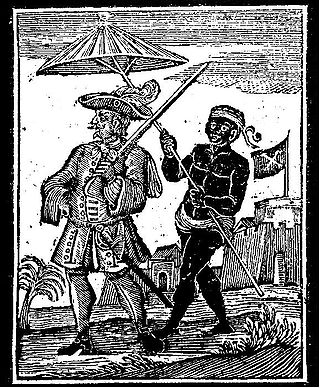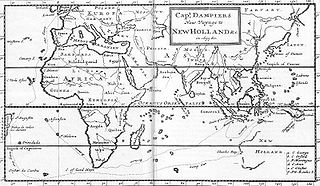
Alexander Hamilton (before 1688 – after 1733) was a Scottish sea captain, privateer and merchant. He later became commander of the Bombay Marine, in charge of suppresing piracy.

Alexander Hamilton (before 1688 – after 1733) was a Scottish sea captain, privateer and merchant. He later became commander of the Bombay Marine, in charge of suppresing piracy.

In his early years he travelled widely through Europe, the Barbary coast, the West Indies, India and Southeast Asia. On his arrival in Bombay in 1688 he was briefly pressed into the employ of the East India Company in a local war, and then set up as a private country trader, operating from Surat, India.
He was appointed commander of the Bombay Marine in June 1717, in which post he suppressed piracy. [1] In 1718, he visited Ayutthaya (present-day Thailand) and his account of his visit there survives.
The main extant source of information on Captain Hamilton is his own book, A New Account of the East Indies (1727). The term 'East Indies' then covered a much wider geographic area than it does today – 'most of the countries and islands of commerce and navigation, between the Cape of Good Hope and the island of Japan'. Illustrated with lively anecdotes, it provides a valuable insight into British involvement in and perception of early modern Asia. [1]
Confusingly, he used the English name Canton to refer to both the walled city (Guangzhou) and the province (Guangdong), but used Canton more often for the city and Quantung occasionally for the province. [2]

The East India Company (EIC) was an English, and later British, joint-stock company founded in 1600 and dissolved in 1874. It was formed to trade in the Indian Ocean region, initially with the East Indies, and later with East Asia. The company gained control of large parts of the Indian subcontinent and colonised parts of Southeast Asia and Hong Kong. At its peak, the company was the largest corporation in the world by various measures and had its own armed forces in the form of the company's three presidency armies, totalling about 260,000 soldiers, twice the size of the British army at the time.

Execution by elephant, or Gunga Rao, was a method of capital punishment in South and Southeast Asia, particularly in India, where Asian elephants were used to crush, dismember, or torture captives during public executions. The animals were trained to kill victims immediately or to torture them slowly over a prolonged period. Most commonly employed by royalty, the elephants were used to signify both the ruler's power of life and death over his subjects and his ability to control wild animals.

Colonial India was the part of the Indian subcontinent that was occupied by European colonial powers during the Age of Discovery. European power was exerted both by conquest and trade, especially in spices. The search for the wealth and prosperity of India led to the colonisation of the Americas after Christopher Columbus went to the Americas in 1492. Only a few years later, near the end of the 15th century, Portuguese sailor Vasco da Gama became the first European to re-establish direct trade links with India by being the first to arrive by circumnavigating Africa. Having arrived in Calicut, which by then was one of the major trading ports of the eastern world, he obtained permission to trade in the city from the Saamoothiri Rajah. The next to arrive were the Dutch, with their main base in Ceylon. Their expansion into India was halted after their defeat in the Battle of Colachel to the Kingdom of Travancore, during the Travancore–Dutch War.

Admiral of the Fleet George Byng, 1st Viscount Torrington,, of Southill Park in Bedfordshire, was a Royal Navy officer and statesman. While still a lieutenant, he delivered a letter from various captains to Prince William of Orange, who had just landed at Torbay, assuring the Prince of the captains' support; the Prince gave Byng a response which ultimately led to the Royal Navy switching allegiance to the Prince and the Glorious Revolution of November 1688.

Admiral Sir Charles Elliot was a British Royal Navy officer, diplomat, and colonial administrator. He became the first Administrator of Hong Kong in 1841 while serving as both Plenipotentiary and Chief Superintendent of British Trade in China. He was a key founder in the establishment of Hong Kong as a British colony.

Henry Every, also known as Henry Avery, sometimes erroneously given as Jack Avery or John Avery, was an English pirate who operated in the Atlantic and Indian oceans in the mid-1690s. He probably used several aliases throughout his career, including Benjamin Bridgeman, and was known as Long Ben to his crewmen and associates.

Elias Hasket Derby was an American merchant based in Salem, Massachusetts who owned or held shares in numerous privateers. The crews of these ships took more than 150 prizes during the American Revolution, and the sale of the prizes resulted in great wealth to be shared. Derby was in business with his father, who died at the end of the war.

Robert Moresby was a captain of the East India Company's Bombay Marine/Indian Navy who distinguished himself as a hydrographer, maritime surveyor and draughtsman.

Charles Gibbs was the pseudonym of an American pirate, born James D. Jeffers. Jeffers was one of the last active pirates in the Caribbean during the early 19th century, and was among the last persons to be executed for piracy by the United States.
Robert Cowan was an Irish colonial administrator and the East India Company's Governor of Bombay from 1729 to 1734. He was a collateral ancestor of the Marquesses of Londonderry through the marriage of his sister, Mary Cowan, to Alexander Stewart, father of Robert Stewart, 1st Marquess of Londonderry.

Johan Nieuhof was a Dutch traveler who wrote about his journeys to Brazil, China and India. The most famous of these was a trip of 2,400 kilometers (1,500 mi) from Canton to Peking in 1655-1657, which enabled him to become an authoritative Western writer on China. He wrote An embassy from the East-India Company containing the written account of this journey.

HMS Wellesley was a 74-gun third rate, named after the Duke of Wellington, and launched in 1815. She captured Karachi for the British, and participated in the First Opium War, which resulted in Britain gaining control of Hong Kong. Thereafter she served primarily as a training ship before gaining the almost surely unwanted distinction of being the last British ship of the line to be sunk by enemy action and the only one to have been sunk by an air-raid.
Alexander Hamilton was the first United States Secretary of the Treasury and one of the Founding Fathers of the United States of America.
Philip Dundas was a Scottish East India Company naval officer, president of the East India Marine Board, and superintendent of Bombay. He returned to Britain and became a member of parliament and returned to the Far East to become governor of Prince of Wales Island, now known as Penang.

China–Portugal relations, can be traced to 1514 during the Ming dynasty of China. Relations between the modern political entities of the People's Republic of China and the Portuguese Republic officially began on 2 February 1979. China and Portugal established the comprehensive strategic partnership in 2005. Both nations maintain friendly relations, which is due to three main reasons- the first being the Portuguese handover of Macau in 1999, the second being the Portuguese prominence in the Lusophone, which includes nations China wishes to promote relations with, and third being the extensive history of Portuguese presence in Asia.

The English overseas possessions, also known as the English colonial empire, comprised a variety of overseas territories that were colonised, conquered, or otherwise acquired by the former Kingdom of England during the centuries before the Acts of Union of 1707 between the Kingdom of England and the Kingdom of Scotland created the Kingdom of Great Britain. The many English possessions then became the foundation of the British Empire and its fast-growing naval and mercantile power, which until then had yet to overtake those of the Dutch Republic, the Kingdom of Portugal, and the Crown of Castile.
Edmund Roberts was an American diplomat. Appointed by President Andrew Jackson, he served as the United States' first envoy to the Far East, and went on USS Peacock on non-resident diplomatic missions to the courts of Cochinchina, Thailand ("Siam") and Muscat and Oman during the years 1832–6.
The 1924 New Year Honours were appointments by King George V to various orders and honours to reward and highlight good works by members of the British Empire. They were published in The London Gazette on 1 January 1924.
The New Year Honours 1922 were appointments by King George V to various orders and honours to reward and highlight good works by members of the British Empire. They were published on 30 December 1921.

Asia was built at Bombay Dockyard in 1797. She made at least two voyages for the British East India Company (EIC) before the British Royal Navy purchased her in 1805 in the East Indies. The Royal Navy renamed her HMS Sir Francis Drake and used her as a frigate. She served in the Java campaign of 1811. When she returned to England in 1813 she was refitted as a storeship. Later, she became the flagship, at Newfoundland, for the governors of Newfoundland. The Admiralty sold her in 1825. New owners renamed her Asia and she sailed between Britain and London until 1831 when Portuguese interests purchased her. She then became the frigate Dona Maria II for the Liberal forces that were attempting to install the rightful queen, Dona Maria II, to the throne of Portugal, and overthrow Dom Miguel, who had usurped the throne. In early 1849 conflict developed between the Portuguese government in Macau and the Chinese government over who could collect taxes and tariffs at Macao. Dona Maria II sailed to Macao as part of a small squadron. An internal explosion destroyed her in the harbour on 29 October.